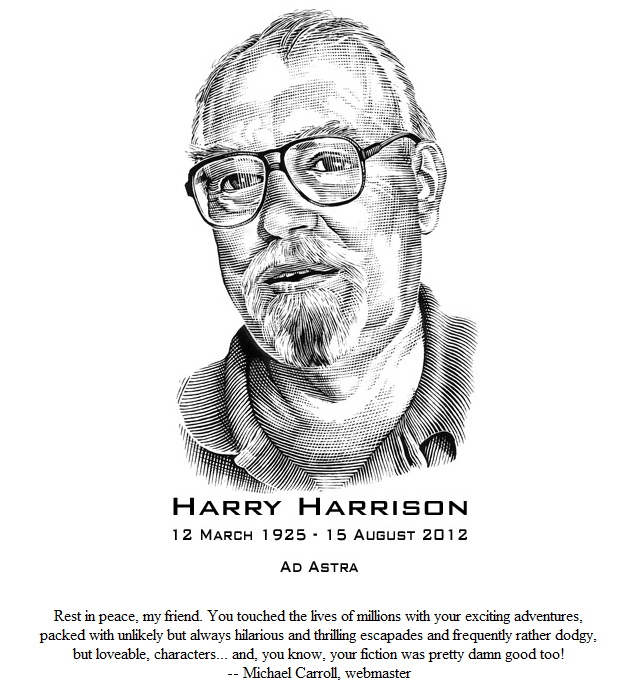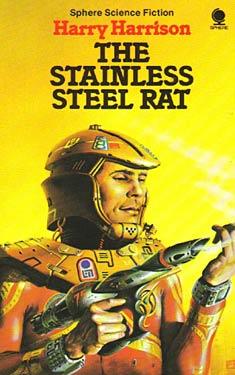Harry Harrison, R.I.P.
Harry Harrison, author of such series as The Stainless Steel Rat and Bill, the Galactic Hero, and 2009 Damon Knight Memorial Grand Master Award inductee, passed away today.
See the author’s site for the official notice.
Harrison’s author page on WWEnd. Notable works: Make Room! Make Room!, The Stainless Steel Rat, Bill, the Galactic Hero.
See also io9’s tribute article.
GMRC Review: The Stainless Steel Rat
 Editor’s Note: On his blog Stainless Steel Droppings blogger Carl V. Anderson reviews SF/F books and movies, conducts author interviews and even hosts his own reading challenge: The 2012 Science Fiction Experience. What better book for his first Grand Master review than Harry Harrison’s The Stainless Steel Rat?
Editor’s Note: On his blog Stainless Steel Droppings blogger Carl V. Anderson reviews SF/F books and movies, conducts author interviews and even hosts his own reading challenge: The 2012 Science Fiction Experience. What better book for his first Grand Master review than Harry Harrison’s The Stainless Steel Rat?
James “Slippery Jim” diGriz is a master criminal, a stainless steel rat in the wainscoting of society, a society that is becoming increasingly devoid of crime thanks to the successful efforts of the galaxy’s infamous Special Corps. Cocky and self-assured, diGriz goes about his business with rare aplomb, each caper uniquely different so as to stay one step ahead of what passes for the law on whatever planet he happens to find himself located. When a particularly clever theft goes awry, Slippery Jim finds himself a cornered rat in a maze that lands him in the lap of the dreaded Special Corps.
And to make matters worse, the inmates are running the asylum, for the Special Corps is headed by none other than the most famous criminal mastermind ever: Harold Inskipp, aka Inskipp the Uncatchable. Soon DiGriz is presented with an offer he cannot refuse. As the old adage goes, “if you can’t beat ‘em, join ‘em”.
At any rate, it is better than having your mind wiped.
The first of Harry Harrison’s popular Stainless Steel Rat series was published in 1961, although portions of the story saw life in Astounding Science Fiction in 1957 and Analog: Science Fact and Fiction in 1960. Slippery Jim DiGriz is the prototypical anti-hero. Skilled in the art of crime and yet highly moralistic in his respect for life, DiGriz is a step nearer the heroic mold in comparison to those protagonists written by Alfred Bester, for example, in The Demolished Man or The Stars My Destination, and he is the precursor for loveable rogues like Han Solo or Malcolm Reynolds. In Jim DiGriz we see some of the vestiges of the chivalry and honor of the 1950’s coupled with the shifting changes in attitude about government that came about in the 1960’s. In addition The Stainless Steel Rat was somewhat prescient in showing a future where the free and casual use of drugs and alcohol was later born out in the late 60’s and in the 1970’s. In fact, The Stainless Steel Rat sits on a very interesting dividing line by including some of the older, now dated ideas that dominated science fiction in the 40’s and 50’s and other ideas about government and crime and the immensity of space that are relevant today.
In James DiGriz’s universe, a bank of psimen was used to send messages telepathically across light years and the future remained filled with a great deal of paper when it came to the wheels of bureaucracy. Computers used punch cards and destinations were laid into starships using course tapes. At the same time Harry Harrison envisioned space as the kind of massive place that even with largely populated galaxies an enormous warship could be impossible to find and envisioned a future in which women were every bit as clever and capable as men. All these things aside, what makes The Stainless Steel Rat a “vintage” novel that remains worth reading today is that it is a fast-paced, witty, fun story with just enough timely twists and turns that it remains satisfying from start to finish.
 Slippery Jim’s schemes are cunning in their planning and execution even when they do not work out entirely as orchestrated and he soon finds out that to be a really good cop in the Special Corps, it pays to keep the criminal skills in good working order. The Stainless Steel Rat is a quick read and I continue to find it absorbing enough that I wouldn’t hesitate to give it to any young boy or girl looking for a rollicking good science fiction adventure, nor to any adult wanting to read something fun with a hint of nostalgia to it. The story never flags, it is paced beautifully, and the dated elements never get in the way of the action.
Slippery Jim’s schemes are cunning in their planning and execution even when they do not work out entirely as orchestrated and he soon finds out that to be a really good cop in the Special Corps, it pays to keep the criminal skills in good working order. The Stainless Steel Rat is a quick read and I continue to find it absorbing enough that I wouldn’t hesitate to give it to any young boy or girl looking for a rollicking good science fiction adventure, nor to any adult wanting to read something fun with a hint of nostalgia to it. The story never flags, it is paced beautifully, and the dated elements never get in the way of the action.
I fell in love with the world of The Stainless Steel Rat as a pre-adolescent, when Slippery Jim and the lovely Angelina were the kind of characters who excited a young boy’s imagination and stirred his emotions. When I got older and picked up the book to read again I discovered that Harry Harrison did what many try to do and fail–he created an adventure/detective series set in a science fictional universe that has a timeless appeal because it is both smarter and better executed than many novels of the same mold that went before and have come after. Not all of the Stainless Steel Rat books are gems, but the first two especially (The Stainless Steel Rat and The Stainless Steel Rat’s Revenge) form a nice two-part tale that holds up well today from a pure enjoyment factor.
After 3+ decades of being a fan of his adventures, I readily admit to a bias towards (most of) Harry Harrison’s Stainless Steel Rat stories. Yet even in my fanatical devotion, witnessed by the title of my blog, I like to think that I have enough objectivity to see that there is really something here. There is a spark that good older science fiction stories have that keeps them popular to some degree today. Slippery Jim DiGriz will delight you with his escapades and you will walk away with a smile on your face, even if it is a wry smile.
It’s Not Easy Being Green
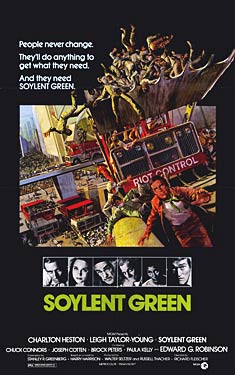
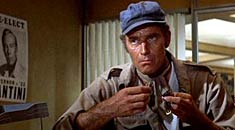
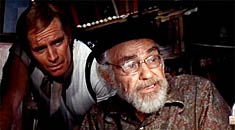
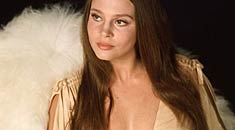
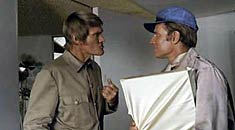
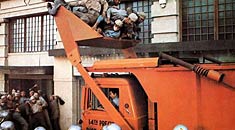
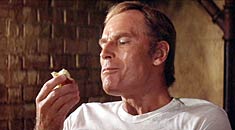
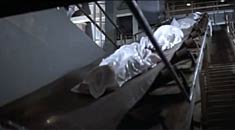
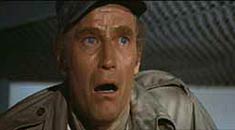
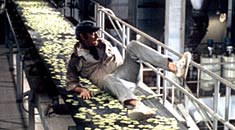
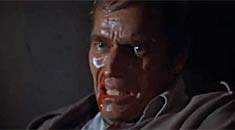
Soylent Green is made out of people.
Even if you haven’t seen 1973’s Soylent Green, you likely already know how it ends. It’s one of the worst kept secrets among sci-fi twist endings. In fact, the ending has become something of a cultural phenomenon, while the film itself is largely forgotten.
(Yeah, sorry for no spoiler alert.)
So, I watched Soylent Green this week, expecting some serious Soylent cheese. Instead, I found a surprisingly smart, gritty and still timely film that is much more than just another Chuck Heston fist-in-the-air primal scream.
Essentially, manly man Heston is a cop named Thorn in a futuristic pre-Giuliani New York circa 2022 with 40 million people, severe environmental damage and massive food shortages. Much of the film looks like it was shot through gauze to simulate the smog and filth of the dystopia. I think that also explains why everyone wears tan clothing. Nothing spells dystopia like tan clothing.
We’re told that real food is no longer available (as most animal life and vegetable life has gone the way of all flesh), so people subsist on Soybean-Lentil (aka Soylent) vegetable concentrates and the new, “plankton-derived” high protein Soylent Green.
That’s plankton if by plankton you mean someone’s Aunt Gertrude.
As the city is wildly overpopulated, most everyone is hideously impoverished and must share living space with other people. Chuck shares a pad with a Lawrence Ferlinghetti clone at what looks like the storage closet at City Lights bookstore. The clone, named Sol Roth, really is the heart of the film – an old man who remembers what life was like when there was life … and food.
It is Sol’s prosaic reminiscences about the good life before the world went to pot (and Heston’s tearful farewell at the old man’s death – sorry again on the no spoiler alert) that properly deliver the film’s message.
Long story short, a big Soylent corporate executive is assassinated and Chuck is on the case. Along the way, Heston very quickly moves in on the exec’s main squeeze and runs afoul of his one-time bodyguard (Rifleman Chuck Connors). Heston must also contend with food riots, whereby thousands of Doobie Brothers fans get bent out of shape and take it to the streets when the Soylent Green supplies run short.
While Heston spends most of the film doing manly 1970’s cop things like getting into fisticuffs and manhandling dames, Sol Roth uncovers the horrible truth about their foodstuffs and decides to opt for good old fashioned state-sanctioned suicide. It’s his deathbed confession and Heston’s subsequent investigation of just what the state does with the bodies that leads to the now famous conclusion of the film.
(Interesting Side Note: Sol Roth is escorted to his doom by none other than Dick Van Patton, the father from Eight is Enough, itself a 1970’s parable on population.)
Of course, I’m just paraphrasing the narrative. The story has grit and heart, it toggles between sci-fi and cop drama, and it’s more than just its punchline ending. For me, the reason the film didn’t make the leap from good to great is Heston himself.
When Heston encounters “the good life” of the dead executive – a good life that we would take for granted – his awe-struck reaction to things such as hot showers, apples and bar soap is supposed to bring home for us how deep is the loss.
But Heston isn’t the right guy for this job. He barrels through the movie as a sensual lout – the kind of guy you don’t want at your party because he swaggers in and drinks everyone else’s drinks. Kind of like that Spaulding kid from Caddyshack, only with a gun. And that damned ascot.
Heston’s square-jawed heroics are ill-fitted for the flawed character of Thorn who’s corrupt, opportunistic and ultimately frail and near hysterical with the corporate malfeasance he uncovers. The problem is that Heston is too macho and overly heroic for the audience to identify with.
Earlier this week, I saw a documentary about Jaws where Spielberg said that Heston wanted to play Chief Brody. Spielberg didn’t want to cast him because he thought that the shark wouldn’t stand a chance against Heston, with him being so larger than life. Spielberg said that Heston was like a 12, when the role of Brody called for an 8.
That was an eureka moment for me. Heston was just too much Heston for Soylent Green. The role of Thorn needed more vulnerability. It needed someone who could convey fear, wonder, weakness and regret in a more genuine way.
This got me to thinking that, recast with Dustin Hoffman, Soylent Green could have been masterful. Filmed at a time when Hoffman was making films like Straw Dogs and Papillon, Soylent Green could have mined deeper into the existential agonies and uncertainties of the 1970’s. The role of Thorn didn’t call for an action hero, but a thinking hero, someone who could richly expose our vulnerability and foolishness as we face the terrible consequences of the environmental monster we created. (Hello, BP.)
Soylent Green probes some interesting questions about human stewardship of the Earth. It deserves more than being relegated as the equivalent of a sci-fi one-liner.
 Editor’s Note: Soylent Green is based on the 1966 book Make Room! Make Room! by Harry Harrison.
Editor’s Note: Soylent Green is based on the 1966 book Make Room! Make Room! by Harry Harrison.



















 Full Details
Full Details
